It is not often we come across an artist who is able to maintain a truly experimental outlook on the creative process after years of achievement, recognition and success. To defy expectations, continue to grow one’s fanbase, and above all keep surprising oneself, is no simple task. To do this, an artist must possess intrepid fortitude, individuality, a captivated (and captivating) intelligence, and an ever-evolving toolbox; in many ways, an artist must remain a fearless and curious student their whole career, regardless of how technically skilled or famous they become.
One such artist is Kursa, alias of renowned British producer Oska Turton. From his expansive solo work and time with Slug Wife collective and K.L.O. to his more recent side projects S.Murk and SNOOZi, Kursa has always been a fountainhead and luminous example of innovative sound design that gambols over a vast lineage of dub, jungle, acid house, jersey club, garage, noise, contemporary classical, and much, much more, to emerge each time with a distinct soundscape unique to the labyrinthine mind of its prolific creator.
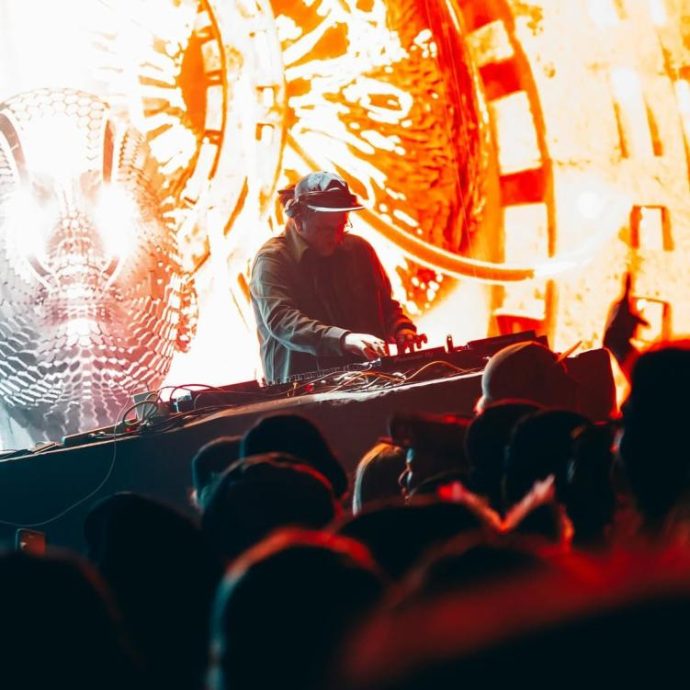
River Beats was thrilled to catch up with Kursa (plus a surprise sit-in from virtuoso violinist and Sn00zi collaborator Alicia Kiah), in the weeks following his two indelible sets at Submersion, to discuss this year’s debut of his live hardware project, the process of its development, and its evolution to his most recent performance at Paradise Lakes.
We were also able to spend some time with Hayley Carloni–visionary VJ, creative director of Fractal Fest, and co-founder of Coven NYC–who provided the oneiric visual delicacies for the one-of-a-kind experience. Read on below to find out what this talented set of risk-taking artists had to say.
Gregory Ross: So let’s talk about your live hardware set from Submersion this year. Incredible performance. How did this transpire, the idea of improvising live with equipment like this instead of a traditional DJ set?
Oska Turton: The thing with the live set, I’ve been planning this for ten years. I’ve been thinking about every single aspect of it for the past ten years, how to get things to sound like mastered tunes, have it be completely improvisational, and be able to change everything out on the fly.
OT: Ever since I was a kid, I never fit into a certain group. I was the weird kid with the weird name that listened to acid techno and jungle–when I was a kid. So I never had a proper social circle growing up. Back then, it felt horrible and really isolating. What I took from that is realizing I can do my own thing and that’s interesting to watch. This has always been my thought with it: doing something completely different, going against the norm.
GR: I’d say you’ve succeeded with that. On many levels.
OT: I mean, I’m a gear nerd. I love drum machines, samplers, effects. Instruments, essentially. I come from a very instrumental background. I played piano as a kid, guitar, a bit of drums. Now, this is my guitar, drums, and piano–synthesizers and buttons–but you can do more. You can sample a guitar and do some weird shit with it instead [laughs]… Now I’m seeing how scalable it is as well. There are different ways I can approach the same thing.
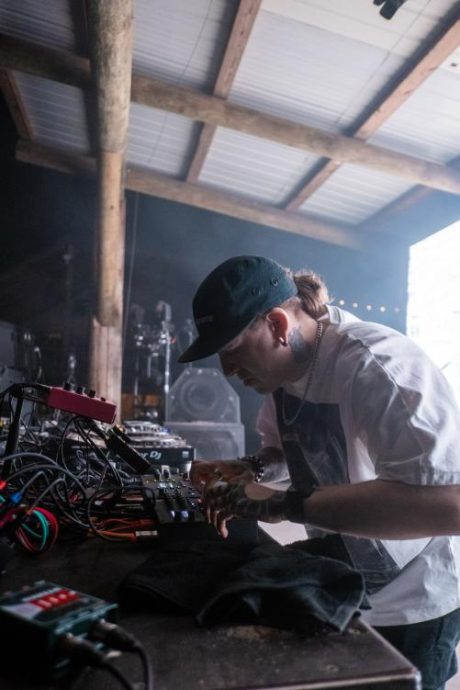
GR: Last March, you performed your debut live hardware set at the Black Box. How did your approach change from that set to Submersion?
OT: Structure, I think. Structure and energy flow. The first one, there wasn’t the same flow that there is in a DJ set, where it’s a build-up of energy. The first was more fractured. I didn’t feel as much thought-out form, but I had to do it first to see [that]. I mean, I’m a performer at the end of the day. I feed off the vibe that I’m given, so I wanted to make something that had more energy to it, that could make the crowd bounce, then I’d bounce a bit more, have that sort of feedback.
GR: Would you say, at the Black Box, you were more tinkering?
OT: Partly. Funny enough, what I feel like I slipped up on there was I didn’t work on it loud enough at home. As soon as you’ve got this live raw sound coming through a sound system, it’s a very different thing. The sheer volume of it, I think, changes the dynamic of the performance. But [for Submersion] that’s something I did at home, is perform it, at volume, very loud, to see what kind of energy that gives me, to see what parts of it excite me at that volume and how much dynamic there is to play with. In the Submersion [live hardware set], I feel like there was more space, but that creates more tension in a way.
I think that’s another thing. I’ve been watching techno guys do a similar sort of thing for years, but to this audience, it’s completely new. I think there has to be a certain level of introduction with things, so there’s more room to build sections so people can become familiar with what’s about to happen. You need to justify things. If you hear where it’s coming from, you can justify it going into something else.
Alicia Kiah: Like an anchor.
OT: Yeah, like a sonic anchor.
GR: In many ways, Submersion is a producer’s festival–heavily attended by producers. This is one of my favorite aspects, having the opportunity to speak with all these creative people in one place. I talked to a number of producers about your hardware set, and one of the things most seemed to be interested in was how you’re able to patch everything together, in a live setting, in a smooth way, building that kind of narrative without sounding chaotic. Would you like to speak on that?
OT: Teaching taught me a lot about my own approach, what I really enjoy in music, what I enjoy in composition. I’ve had to dissect my own method to be able to show other people what I find interesting or effective. And what I have found very effective is minimalism: getting the most out of the least. You don’t want to make things too busy, but you always want to keep it interesting.
A lot of it is trickery of movement, using not much but making it all move at the same time. You have to approach it like mixing a tune, essentially, but on the fly. If anyone’s watched my Twitch videos, they see how quickly I work with that. You have to do the same thing there. The key is you have to know your gear. You’ve got to obsess over it and know what it all does, how it sounds–keeping it balanced, very loosely organized chaos. It’s easier to organize a lot less stuff. Minimalism is key.
GR: Speaking of gear, what hardware did you use specifically for this set? Can you explain each component?
OT: I can try [laughs]. There are four main things, essentially. There’s the Octatrack, which is a sampler. Primarily, I use that for drums, that kind of stuff. Coming from a jungly/hip-hop/sample background, I prefer sampled breaks and that kind of sound. You just can’t really synthesize that. Another piece of gear I used was an Elektron Syntakt. That’s a synthesizer. I use that to create melodies.
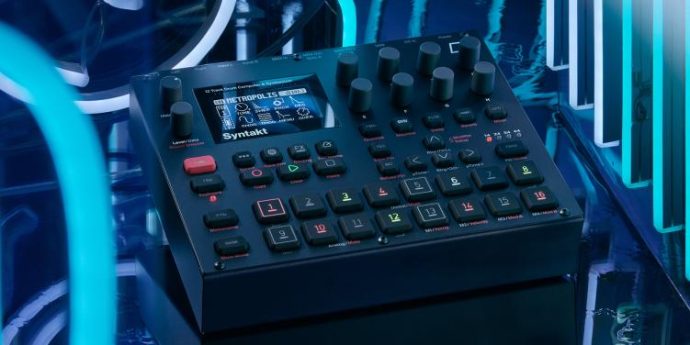
OT: All of that goes into an OTO Bébé Chérie. I use that for level control, but then it has end-of-chain effects, such as a compressor, which just makes everything glue and sound a bit more together. You can throw multiple instruments into it, and it’ll bring them all to the same sort of level, and then a high end, because you’ll lose a lot of high end when you compress things. That brings it back. Makes it sound together and bright, which makes it sound sort of mastered.
It’s the kind of thing I think has been missed in a couple of live bits of gear, this end-of-chain thing that makes it sound like a mixed tune. It’s the same as running a guitar through a bunch of effects pedals. I’m trying to find color and warmth. This is essentially a big effects pedal for all my instruments to go through. Does that make sense?
GR: Absolutely.
OT: There are two other channels on it as well. Just to make it even more confusing [laughs]. I’ve got a dry chain and a wet chain. I’ll have my normal dry sound, and at any point I’ll have the ability to throw it into an effect to make it sustain. I’ll use that to blend between sections. On the Octatrack, the drums, I’ll have that going through a BASTL Thyme, which is a delay. Then I can add a delay to the drums. It has some really nice effects. That’s how I mangle it up and make it sound like it’s falling apart.
The Syntakt is going through a small modular rig, which has a Mutable Instruments Clouds on it, and then a Xaoc Timiszoara, which is a multi effects unit, so at any point, I can throw that into more spatial effects, such as reverbs and more droney, atmospheric things. Basically, at all times, I’ve got a rhythmical aspect and a melodic aspect. Each one of those could be sustained indefinitely at the touch of a button. That way, you can blend between having rhythmical parts and textural, droney, hypnotic sections as well.
I could talk about this shit for hours and it’ll get mad complicated. The cool thing is you can switch out any of these elements and have a completely different set. That’s where I’m going with this. You can change it and scale it. You can take something away, put something in, and the whole thing will be different. You’ll never see the same thing. Ever. It’s going to happen, and that’s it, it’s done. I love that.
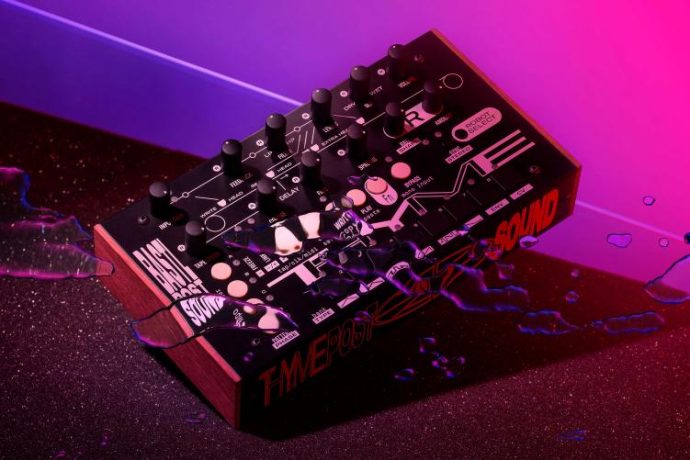
GR: Is that what attracts you to working this way and exploring what you can do with hardware improvisation in a live setting?
OT: That’s it. I mean, there’s a couple things I love about it. I basically produce in this way: I’ll make a bunch of things work, make these weird sounds, and then I’ll record everything, chop bits out. I like the terror of having to do that immediately. But also, it’s not just the fear of fucking up, it’s that you have so much more control over it. If you play a tune in a DJ set that bombs, you have to find another tune. If you play a sound in a live set, you can change that sound, take that bit away. It’s more immediate if you’re trying to convey something. You’ve got more control.
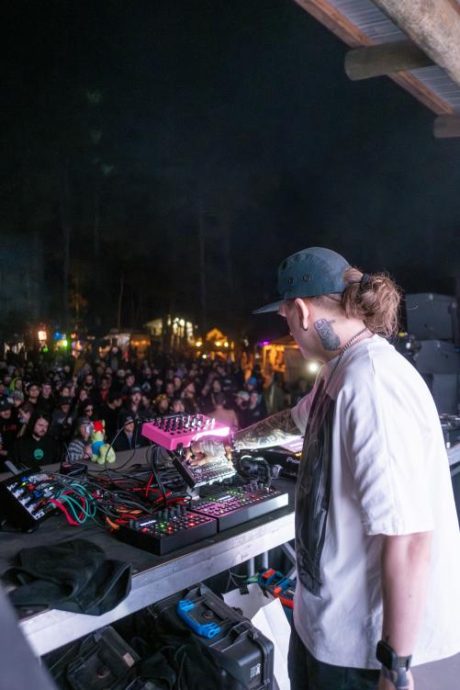
GR: In many ways, it’s bridging the electronic scene with live instrumentation. When a guitarist plays a wrong note on stage, they have to respond to that in the moment. DJs don’t really have that ability, nor do they lead themselves into the same areas of risk that you would in orchestral performances, say, or any kind of live instrumentation… You mentioned that you’ve been watching people do this in techno for a while. Who has been the greatest influence to you in this regard?
OT: For me, it’s the obvious ones I’ve caught in Bristol over the years. You’ve got Blawan and Pariah, their current project, which is unreal. Surgeon is a classic. Ben Pest, obviously. Ben Pest has to have a massive mention here. The guy literally taught me how to use the Octatrack. I actually did a live set with him in Bristol, at a 3D-immersive soundscape venue called DareShack. Ben Pest has been pioneering this shit for years.
GR: I didn’t realize that.
OT: [Ben Pest] goes way back. He got me really excited about actually taking this stuff live, taking the leap. The way he performs live inspired me to start doing this myself more than anyone else. When I stood next to him, performing together, he was losing it, so stoked. He was just throwing things, being so slapdash–so much energy. I just fed off that. I was like, “Holy shit, that’s where I want to be.” I want to have that level of love and excitement. He’s fearless, man, absolutely fearless in the live context. I’m desperate to get him out here and do something like that with him here.
GR: That would be awesome. Would you say you were happy with how everything turned out at Submersion?
OT: I couldn’t have been happier with how it went. I didn’t really have any expectations going into it. I was just like, “I’m going to do this. Maybe people will be here. Maybe people are going to be into it.” I was terrified, and then people were into it, man.
GR: It was my favorite set at Submersion.
OT: Word. It felt different. It felt like a different experience for me. It was something else entirely. I can’t remember the last time I felt like that. At least, not without drugs anyway [laughs].
GR: It’s its own drug, performing like that. You’re creating your high.
OT: This is it, man. I really felt something that I hadn’t felt in years, doing that. It was interesting. I can’t wait to obsess over it more now.
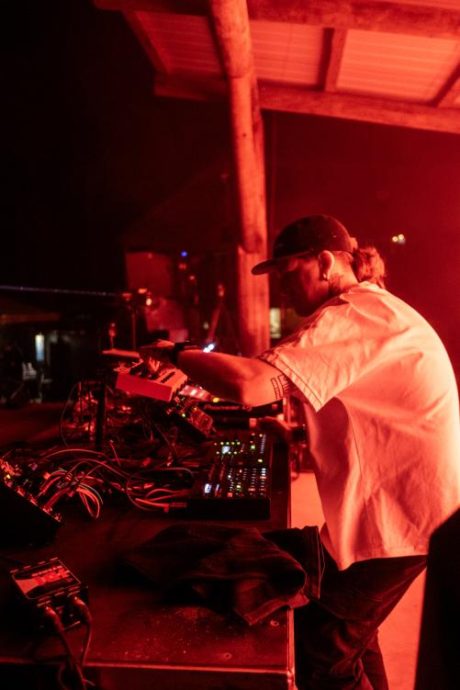
GR: What do you have in the works as far as this vein goes? Do you think it can have the same effect in an album format that it has live, or are you more focused on the live aspect, building something in the moment?
OT: For me, it’s going to be closer to a punk album. Listening to a punk album never sounds the same as seeing it live. It’s got to be janky around the edges to make it sound rough and real. I don’t know if that could be recorded and listened to in the same way. I think it has to be live. At this stage, anyway. I’m sure at some point there’s going to be another recorded set, something a bit more concise, but for something like that, for repeated listens, I’d want it to sound different. But it’s early days. I’ve only done this three times, including the Ben Pest thing.
GR: There are going to be bootleg recordings going around of Kursa hardware sets [laughs].
OT: Fuck it [laughs], I’m all for it. If people are talking to each other and sharing something, then that’s real. People relating to each other and having a conversation about music, that’s a win for me.
GR: Earlier, you used the word “space.” I noticed that space was a heavy element as well. In general, the use of space in art is often missed in a rush to clutter, add, fill. Your set, you dragged people through this industrial, uncertain type of flow, a kind of tottering hypnosis, and then you came out with all those technical layers. Space gives that a different kind of force. It’s important.
OT: Yeah, I’m sure I could do that in a DJ set, but I get way too scared of people not dancing [laughs]. I suppose what I prefer about the live set for doing that, and having that tension and release, is I get so fucking self-indulgent. I’m just like, “This is for me. I’m going to make you wait.” I’ve got all my toys on stage. I feel like I’m allowed to sort of play with space a bit more, which is weird. I’ve got a lot more freedom with it than I do in a DJ set. If you compare it to the Beats set from the night before, I have no idea where that came from [laughs]. It was the heaviest set I’ve played in years, and then the next set was this slow, churning, building thing, the complete opposite. It’s crazy.
GR: How much preparation did you do for the Beats set?
OT: I did loads. And then I completely changed it just before I went on. The main bit of prep that didn’t change was me and Alicia [Kiah] performing at the start. I love that little narrative as well. We opened the Beats set together with a live element, and then I closed the Live [Hardware] set with a beats-y element. It was full circle.
AK: It’s being eccentric and different with what parameters you’re given.
OT: This is it. Respect to Jesse, Ryan, Kristen, Ethan, Katie, all these guys, for being like, “Go for it.” That’s what sets Submersion apart from other festivals, I think. That stood out to me more than any festival I’ve been to in years–people were actually experimenting.
GR: So you mentioned that this live hardware stuff is what you’re going to be focusing on going forward. Can we expect more performances through 2025?
OT: Lots of exciting things coming. The focus for next year, for the live stuff, is taking this into uncharted territory. Something unique as the performance itself is finding spaces and [making] experiences that mirror that, to make it something all encompassing and make it something completely different that’s as exciting in every aspect and completely obsessive in every aspect as well.
GR: Let’s talk about Hayley Carloni’s visuals. What a great pairing. Her visual style is unique for this scene, in general. Reminded me of the time I saw Tool. Did you work with her at all beforehand?
OT: Nope, never met. Which was perfect, I think. Honestly, I feel like it was the perfect pairing. I sent her a message and looked at some of her stuff, sent her a snippet of what I was doing, but there was no real planning. I saw a bit of her work, and I was like, “That looks fucking sick and weird. I’m into that.”
GR: Definitely brought out the deep industrial vibes in your set.
OT: This is it. I personally really liked it because it was something I hadn’t seen before. It was completely different, taking a bunch of risks. That matched the vibe perfectly. Of course, [Hayley Carloni] is using lots of weird data-moshing and data-degradation techniques, which is effectively what I do with sound as well. The techniques were similar in a lot of regards because they rely heavily on repetition and degradation. Found footage, as well, and lots of real-life footage.
Hayley Carloni
River Beats was also thrilled to spend some time with Hayley Carloni to talk about her creative process and experience preparing for and performing with Kursa at Submersion…
Gregory Ross: Hayley, how would you describe your approach to creating visuals?
Hayley Carloni: I often get visions, which can be triggered by a lot of things, like my dreams, a music track, an interesting prop or costume piece, or even a location. From there, the other parts usually fall into place. I really enjoy making it a collaborative process and often create with my friends, who also happen to be amazing on camera and are willing to do whatever crazy thing I come up with. It’s a very symbiotic and organic process.
On the flip side, I also really enjoy the hunt for pre-existing clips. Archive.org is my favorite for finding anything from vintage advertisements to porn from the 70s/80s. However, I never leave the clips in their original form. I like to “upcycle” them, you could say, by altering them in After Effects. Data-moshing is one of my favorite techniques to execute there.
GR: How did this impact your collaboration with Kursa for his live hardware set?
HC: I knew a few months beforehand that I was going to be paired with Kursa, so during every shoot, I had his music playing on repeat to help set the vibe. I listened to his music pretty obsessively when brainstorming the concepts as well. I’ve been pretty obsessed with the concept of decay for some time now. I dabble in urbex and love to incorporate content I’ve taken of forgotten and abandoned places. This, in combination with the notion of digital decay, like bad tracking from a VHS tape and the technique of data-moshing, all play into this concept. When Kursa found out I was paired with him, he let me know that he would literally be data-moshing sonically during his live hardware set. So we couldn’t have been a more perfectly aligned pair. I knew the majority of his set was going to be improvised, so I tried to approach my set in a similar fashion. He drove the ship, and I just tried to flow in tandem.
GR: I notice you use a lot of film sequences in your visual work. Do you primarily film these sections yourself?
HC: Yes, good catch! For Kursa’s set, 90% of the content was original and shot by yours truly. My background in video production goes way back to when I taught myself at age 9 how to edit with VCRs, and then I went on to study and shoot on 16mm and 35mm film in college. I like to approach my content as if they are mini-films. I get a lot of joy from the process of it all—from pre-production, casting, art direction, location scouting, cinematography, to post-production. It’s my happy place. I also try to lean into the imperfections of a shoot; sometimes, the more lo-fi, the better.
GR: Who or what are your greatest influences?
HC: Reed Morano, David Lynch, 404 Zero, Gaspar Noe, Es Devlin, electronic music, BDSM/kink culture, my talented friends, and all the women/non-binary VJs out there doing the damn thing.
CLOSING WORDS
Gregory Ross: Well, Oska, is there anything else you want to tell us about the Kursa project or Oska Turton himself? Any historical anecdotes?
Oska Turton: I don’t think people need to know too much about my history [laughs].
GR: I’ll just leave them the Last FM thing [laughs].
OT: Fuck sake, man. You know, people have used that to sign me into hotels. Looking through and they can’t see Oska Turton. I’m like, “Is there an Oska Jurgan Borache?” Oh yeah, here he is [laughs].
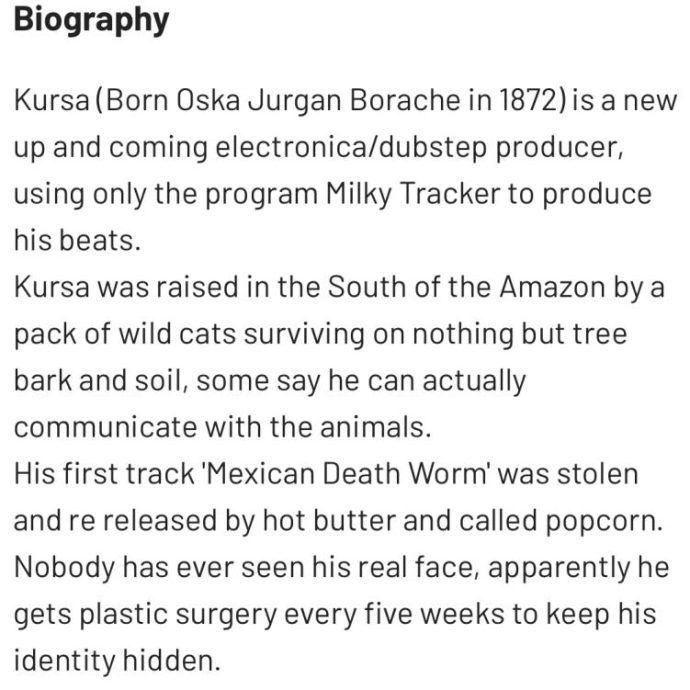
OT: There are a couple things that happened, that kind of led us to this point [laughs]. Fuck it, a little backstory. I was born in London and grew up between there, Kent, up north in Liverpool. I was all over, basically. Primarily, my experience of music started in London. From a young age, I was attending squat parties and illegal warehouse raves that my close friends were putting on. Acid techno, jungle, really extreme underground music in London through the nineties. I’ve been around it the whole time. Seeing that shit from a very early age. The rave is the only thing that’s normal to me [laughs].
It’s a gift and a curse. It just means normal society is a nightmare for me. I’m always waiting for the next fucking party. Even as a kid, that was it. I was like, “When are we going to the next squat party.” It was crazy, but I got to see a lot of weird shit.
GR: Sounds formative.
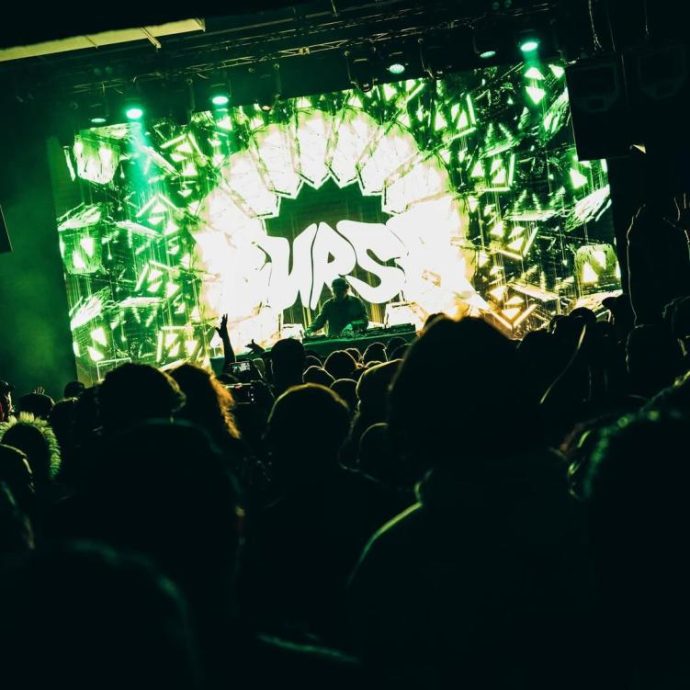
OT: Yeah, the entire nineties in the London underground. Crazy, dude. Absolutely insane.
Alicia Kiah: And it might never happen like that, probably ever again. At least for another hundred years or something.
OT: I don’t know. That shit is born out of desperate times, and I think everything is getting really bad right now. I think we are on the cusp of a cultural revolution. I think we are right fucking there. I think all the things are in the right places. Just think, it’s impossible to envision what is going to happen next year. It’s never been like that before. Never been this uncertain before. I think we’re in a time of pure uncertainty.
AK: And polarity.
OT: Yeah, everything is very polarized. It could go any way. That’s slightly terrifying, but it’s also really exciting. More than ever, I feel very encouraged to do my own thing, because we are right on the edge. It’s like, either the world is going to explode, or there’s going to be war, and with the rise of AI art, it’s like– Take more risks than you’ve ever taken. That’s where your value is, being a risk taker. It doesn’t take any bravado to enter a prompt, does it? What does that cost you? Nothing.
GR: I completely agree. Where we’re at in the world, unfortunate as it may be, is what breeds the next creative movement. I don’t even think we’ve seen the effect of the post-COVID years yet, and the way the economy is… I think we are definitely on the doorstep of something big, and it’s going to be in music, art, literature, literally everything. We just haven’t seen how it all comes together yet.
OT: The thing is, right now, if you want to make money in music, you have to completely sell out. That’s the only way to do it, so the only people who are going to be left in the underground are people doing it cause they fucking love it. I think that’s really good. That’s my favorite place to be. I’ve always been broke, but I’ve always loved making music. Right now, all you can be in this for is making music, so I’m going to pile myself into more debt, get more synths, and make some sick tunes.
GR: Hell yeah. I can’t wait to hear what you cook up next. Thank you for taking the time to speak with me today.
Stay up to date with Kursa’s many projects, releases, live hardware streams, and performances to come at the links below, and don’t sleep on subscribing to “Kurs’d Earth” (Kursa’s Bandcamp) if you want to treat yourself to the otherworldly output this musical menace always seems hard at work brewing in the lab for our eager ears.
Follow Kursa:
Bandcamp | Facebook | Instagram | SoundCloud


It is not often we come across an artist who is able to maintain a truly experimental outlook on the creative process after years of achievement, recognition and success. To defy expectations, continue to grow one’s fanbase, and above all keep surprising oneself, is no simple task. To do this, an artist must possess intrepid fortitude, individuality, a captivated (and captivating) intelligence, and an ever-evolving toolbox; in many ways, an artist must remain a fearless and curious student their whole career, regardless of how technically skilled or famous they become.
One such artist is Kursa, alias of renowned British producer Oska Turton. From his expansive solo work and time with Slug Wife collective and K.L.O. to his more recent side projects S.Murk and SNOOZi, Kursa has always been a fountainhead and luminous example of innovative sound design that gambols over a vast lineage of dub, jungle, acid house, jersey club, garage, noise, contemporary classical, and much, much more, to emerge each time with a distinct soundscape unique to the labyrinthine mind of its prolific creator.
River Beats was thrilled to catch up with Kursa (plus a surprise sit-in from virtuoso violinist and Sn00zi collaborator Alicia Kiah), in the weeks following his two indelible sets at Submersion, to discuss this year’s debut of his live hardware project, the process of its development, and its evolution to his most recent performance at Paradise Lakes.
We were also able to spend some time with Hayley Carloni–visionary VJ, creative director of Fractal Fest, and co-founder of Coven NYC–who provided the oneiric visual delicacies for the one-of-a-kind experience. Read on below to find out what this talented set of risk-taking artists had to say.
Gregory Ross: So let’s talk about your live hardware set from Submersion this year. Incredible performance. How did this transpire, the idea of improvising live with equipment like this instead of a traditional DJ set?
Oska Turton: The thing with the live set, I’ve been planning this for ten years. I’ve been thinking about every single aspect of it for the past ten years, how to get things to sound like mastered tunes, have it be completely improvisational, and be able to change everything out on the fly.
OT: Ever since I was a kid, I never fit into a certain group. I was the weird kid with the weird name that listened to acid techno and jungle–when I was a kid. So I never had a proper social circle growing up. Back then, it felt horrible and really isolating. What I took from that is realizing I can do my own thing and that’s interesting to watch. This has always been my thought with it: doing something completely different, going against the norm.
GR: I’d say you’ve succeeded with that. On many levels.
OT: I mean, I’m a gear nerd. I love drum machines, samplers, effects. Instruments, essentially. I come from a very instrumental background. I played piano as a kid, guitar, a bit of drums. Now, this is my guitar, drums, and piano–synthesizers and buttons–but you can do more. You can sample a guitar and do some weird shit with it instead [laughs]… Now I’m seeing how scalable it is as well. There are different ways I can approach the same thing.
GR: Last March, you performed your debut live hardware set at the Black Box. How did your approach change from that set to Submersion?
OT: Structure, I think. Structure and energy flow. The first one, there wasn’t the same flow that there is in a DJ set, where it’s a build-up of energy. The first was more fractured. I didn’t feel as much thought-out form, but I had to do it first to see [that]. I mean, I’m a performer at the end of the day. I feed off the vibe that I’m given, so I wanted to make something that had more energy to it, that could make the crowd bounce, then I’d bounce a bit more, have that sort of feedback.
GR: Would you say, at the Black Box, you were more tinkering?
OT: Partly. Funny enough, what I feel like I slipped up on there was I didn’t work on it loud enough at home. As soon as you’ve got this live raw sound coming through a sound system, it’s a very different thing. The sheer volume of it, I think, changes the dynamic of the performance. But [for Submersion] that’s something I did at home, is perform it, at volume, very loud, to see what kind of energy that gives me, to see what parts of it excite me at that volume and how much dynamic there is to play with. In the Submersion [live hardware set], I feel like there was more space, but that creates more tension in a way.
I think that’s another thing. I’ve been watching techno guys do a similar sort of thing for years, but to this audience, it’s completely new. I think there has to be a certain level of introduction with things, so there’s more room to build sections so people can become familiar with what’s about to happen. You need to justify things. If you hear where it’s coming from, you can justify it going into something else.
Alicia Kiah: Like an anchor.
OT: Yeah, like a sonic anchor.
GR: In many ways, Submersion is a producer’s festival–heavily attended by producers. This is one of my favorite aspects, having the opportunity to speak with all these creative people in one place. I talked to a number of producers about your hardware set, and one of the things most seemed to be interested in was how you’re able to patch everything together, in a live setting, in a smooth way, building that kind of narrative without sounding chaotic. Would you like to speak on that?
OT: Teaching taught me a lot about my own approach, what I really enjoy in music, what I enjoy in composition. I’ve had to dissect my own method to be able to show other people what I find interesting or effective. And what I have found very effective is minimalism: getting the most out of the least. You don’t want to make things too busy, but you always want to keep it interesting.
A lot of it is trickery of movement, using not much but making it all move at the same time. You have to approach it like mixing a tune, essentially, but on the fly. If anyone’s watched my Twitch videos, they see how quickly I work with that. You have to do the same thing there. The key is you have to know your gear. You’ve got to obsess over it and know what it all does, how it sounds–keeping it balanced, very loosely organized chaos. It’s easier to organize a lot less stuff. Minimalism is key.
GR: Speaking of gear, what hardware did you use specifically for this set? Can you explain each component?
OT: I can try [laughs]. There are four main things, essentially. There’s the Octatrack, which is a sampler. Primarily, I use that for drums, that kind of stuff. Coming from a jungly/hip-hop/sample background, I prefer sampled breaks and that kind of sound. You just can’t really synthesize that. Another piece of gear I used was an Elektron Syntakt. That’s a synthesizer. I use that to create melodies.
OT: All of that goes into an OTO Bébé Chérie. I use that for level control, but then it has end-of-chain effects, such as a compressor, which just makes everything glue and sound a bit more together. You can throw multiple instruments into it, and it’ll bring them all to the same sort of level, and then a high end, because you’ll lose a lot of high end when you compress things. That brings it back. Makes it sound together and bright, which makes it sound sort of mastered.
It’s the kind of thing I think has been missed in a couple of live bits of gear, this end-of-chain thing that makes it sound like a mixed tune. It’s the same as running a guitar through a bunch of effects pedals. I’m trying to find color and warmth. This is essentially a big effects pedal for all my instruments to go through. Does that make sense?
GR: Absolutely.
OT: There are two other channels on it as well. Just to make it even more confusing [laughs]. I’ve got a dry chain and a wet chain. I’ll have my normal dry sound, and at any point I’ll have the ability to throw it into an effect to make it sustain. I’ll use that to blend between sections. On the Octatrack, the drums, I’ll have that going through a BASTL Thyme, which is a delay. Then I can add a delay to the drums. It has some really nice effects. That’s how I mangle it up and make it sound like it’s falling apart.
The Syntakt is going through a small modular rig, which has a Mutable Instruments Clouds on it, and then a Xaoc Timiszoara, which is a multi effects unit, so at any point, I can throw that into more spatial effects, such as reverbs and more droney, atmospheric things. Basically, at all times, I’ve got a rhythmical aspect and a melodic aspect. Each one of those could be sustained indefinitely at the touch of a button. That way, you can blend between having rhythmical parts and textural, droney, hypnotic sections as well.
I could talk about this shit for hours and it’ll get mad complicated. The cool thing is you can switch out any of these elements and have a completely different set. That’s where I’m going with this. You can change it and scale it. You can take something away, put something in, and the whole thing will be different. You’ll never see the same thing. Ever. It’s going to happen, and that’s it, it’s done. I love that.
GR: Is that what attracts you to working this way and exploring what you can do with hardware improvisation in a live setting?
OT: That’s it. I mean, there’s a couple things I love about it. I basically produce in this way: I’ll make a bunch of things work, make these weird sounds, and then I’ll record everything, chop bits out. I like the terror of having to do that immediately. But also, it’s not just the fear of fucking up, it’s that you have so much more control over it. If you play a tune in a DJ set that bombs, you have to find another tune. If you play a sound in a live set, you can change that sound, take that bit away. It’s more immediate if you’re trying to convey something. You’ve got more control.
GR: In many ways, it’s bridging the electronic scene with live instrumentation. When a guitarist plays a wrong note on stage, they have to respond to that in the moment. DJs don’t really have that ability, nor do they lead themselves into the same areas of risk that you would in orchestral performances, say, or any kind of live instrumentation… You mentioned that you’ve been watching people do this in techno for a while. Who has been the greatest influence to you in this regard?
OT: For me, it’s the obvious ones I’ve caught in Bristol over the years. You’ve got Blawan and Pariah, their current project, which is unreal. Surgeon is a classic. Ben Pest, obviously. Ben Pest has to have a massive mention here. The guy literally taught me how to use the Octatrack. I actually did a live set with him in Bristol, at a 3D-immersive soundscape venue called DareShack. Ben Pest has been pioneering this shit for years.
GR: I didn’t realize that.
OT: [Ben Pest] goes way back. He got me really excited about actually taking this stuff live, taking the leap. The way he performs live inspired me to start doing this myself more than anyone else. When I stood next to him, performing together, he was losing it, so stoked. He was just throwing things, being so slapdash–so much energy. I just fed off that. I was like, “Holy shit, that’s where I want to be.” I want to have that level of love and excitement. He’s fearless, man, absolutely fearless in the live context. I’m desperate to get him out here and do something like that with him here.
GR: That would be awesome. Would you say you were happy with how everything turned out at Submersion?
OT: I couldn’t have been happier with how it went. I didn’t really have any expectations going into it. I was just like, “I’m going to do this. Maybe people will be here. Maybe people are going to be into it.” I was terrified, and then people were into it, man.
GR: It was my favorite set at Submersion.
OT: Word. It felt different. It felt like a different experience for me. It was something else entirely. I can’t remember the last time I felt like that. At least, not without drugs anyway [laughs].
GR: It’s its own drug, performing like that. You’re creating your high.
OT: This is it, man. I really felt something that I hadn’t felt in years, doing that. It was interesting. I can’t wait to obsess over it more now.
GR: What do you have in the works as far as this vein goes? Do you think it can have the same effect in an album format that it has live, or are you more focused on the live aspect, building something in the moment?
OT: For me, it’s going to be closer to a punk album. Listening to a punk album never sounds the same as seeing it live. It’s got to be janky around the edges to make it sound rough and real. I don’t know if that could be recorded and listened to in the same way. I think it has to be live. At this stage, anyway. I’m sure at some point there’s going to be another recorded set, something a bit more concise, but for something like that, for repeated listens, I’d want it to sound different. But it’s early days. I’ve only done this three times, including the Ben Pest thing.
GR: There are going to be bootleg recordings going around of Kursa hardware sets [laughs].
OT: Fuck it [laughs], I’m all for it. If people are talking to each other and sharing something, then that’s real. People relating to each other and having a conversation about music, that’s a win for me.
GR: Earlier, you used the word “space.” I noticed that space was a heavy element as well. In general, the use of space in art is often missed in a rush to clutter, add, fill. Your set, you dragged people through this industrial, uncertain type of flow, a kind of tottering hypnosis, and then you came out with all those technical layers. Space gives that a different kind of force. It’s important.
OT: Yeah, I’m sure I could do that in a DJ set, but I get way too scared of people not dancing [laughs]. I suppose what I prefer about the live set for doing that, and having that tension and release, is I get so fucking self-indulgent. I’m just like, “This is for me. I’m going to make you wait.” I’ve got all my toys on stage. I feel like I’m allowed to sort of play with space a bit more, which is weird. I’ve got a lot more freedom with it than I do in a DJ set. If you compare it to the Beats set from the night before, I have no idea where that came from [laughs]. It was the heaviest set I’ve played in years, and then the next set was this slow, churning, building thing, the complete opposite. It’s crazy.
GR: How much preparation did you do for the Beats set?
OT: I did loads. And then I completely changed it just before I went on. The main bit of prep that didn’t change was me and Alicia [Kiah] performing at the start. I love that little narrative as well. We opened the Beats set together with a live element, and then I closed the Live [Hardware] set with a beats-y element. It was full circle.
AK: It’s being eccentric and different with what parameters you’re given.
OT: This is it. Respect to Jesse, Ryan, Kristen, Ethan, Katie, all these guys, for being like, “Go for it.” That’s what sets Submersion apart from other festivals, I think. That stood out to me more than any festival I’ve been to in years–people were actually experimenting.
GR: So you mentioned that this live hardware stuff is what you’re going to be focusing on going forward. Can we expect more performances through 2025?
OT: Lots of exciting things coming. The focus for next year, for the live stuff, is taking this into uncharted territory. Something unique as the performance itself is finding spaces and [making] experiences that mirror that, to make it something all encompassing and make it something completely different that’s as exciting in every aspect and completely obsessive in every aspect as well.
GR: Let’s talk about Hayley Carloni’s visuals. What a great pairing. Her visual style is unique for this scene, in general. Reminded me of the time I saw Tool. Did you work with her at all beforehand?
OT: Nope, never met. Which was perfect, I think. Honestly, I feel like it was the perfect pairing. I sent her a message and looked at some of her stuff, sent her a snippet of what I was doing, but there was no real planning. I saw a bit of her work, and I was like, “That looks fucking sick and weird. I’m into that.”
GR: Definitely brought out the deep industrial vibes in your set.
OT: This is it. I personally really liked it because it was something I hadn’t seen before. It was completely different, taking a bunch of risks. That matched the vibe perfectly. Of course, [Hayley Carloni] is using lots of weird data-moshing and data-degradation techniques, which is effectively what I do with sound as well. The techniques were similar in a lot of regards because they rely heavily on repetition and degradation. Found footage, as well, and lots of real-life footage.
Hayley Carloni
River Beats was also thrilled to spend some time with Hayley Carloni to talk about her creative process and experience preparing for and performing with Kursa at Submersion…
Gregory Ross: Hayley, how would you describe your approach to creating visuals?
Hayley Carloni: I often get visions, which can be triggered by a lot of things, like my dreams, a music track, an interesting prop or costume piece, or even a location. From there, the other parts usually fall into place. I really enjoy making it a collaborative process and often create with my friends, who also happen to be amazing on camera and are willing to do whatever crazy thing I come up with. It’s a very symbiotic and organic process.
On the flip side, I also really enjoy the hunt for pre-existing clips. Archive.org is my favorite for finding anything from vintage advertisements to porn from the 70s/80s. However, I never leave the clips in their original form. I like to “upcycle” them, you could say, by altering them in After Effects. Data-moshing is one of my favorite techniques to execute there.
GR: How did this impact your collaboration with Kursa for his live hardware set?
HC: I knew a few months beforehand that I was going to be paired with Kursa, so during every shoot, I had his music playing on repeat to help set the vibe. I listened to his music pretty obsessively when brainstorming the concepts as well. I’ve been pretty obsessed with the concept of decay for some time now. I dabble in urbex and love to incorporate content I’ve taken of forgotten and abandoned places. This, in combination with the notion of digital decay, like bad tracking from a VHS tape and the technique of data-moshing, all play into this concept. When Kursa found out I was paired with him, he let me know that he would literally be data-moshing sonically during his live hardware set. So we couldn’t have been a more perfectly aligned pair. I knew the majority of his set was going to be improvised, so I tried to approach my set in a similar fashion. He drove the ship, and I just tried to flow in tandem.
GR: I notice you use a lot of film sequences in your visual work. Do you primarily film these sections yourself?
HC: Yes, good catch! For Kursa’s set, 90% of the content was original and shot by yours truly. My background in video production goes way back to when I taught myself at age 9 how to edit with VCRs, and then I went on to study and shoot on 16mm and 35mm film in college. I like to approach my content as if they are mini-films. I get a lot of joy from the process of it all—from pre-production, casting, art direction, location scouting, cinematography, to post-production. It’s my happy place. I also try to lean into the imperfections of a shoot; sometimes, the more lo-fi, the better.
GR: Who or what are your greatest influences?
HC: Reed Morano, David Lynch, 404 Zero, Gaspar Noe, Es Devlin, electronic music, BDSM/kink culture, my talented friends, and all the women/non-binary VJs out there doing the damn thing.
CLOSING WORDS
Gregory Ross: Well, Oska, is there anything else you want to tell us about the Kursa project or Oska Turton himself? Any historical anecdotes?
Oska Turton: I don’t think people need to know too much about my history [laughs].
GR: I’ll just leave them the Last FM thing [laughs].
OT: Fuck sake, man. You know, people have used that to sign me into hotels. Looking through and they can’t see Oska Turton. I’m like, “Is there an Oska Jurgan Borache?” Oh yeah, here he is [laughs].
OT: There are a couple things that happened, that kind of led us to this point [laughs]. Fuck it, a little backstory. I was born in London and grew up between there, Kent, up north in Liverpool. I was all over, basically. Primarily, my experience of music started in London. From a young age, I was attending squat parties and illegal warehouse raves that my close friends were putting on. Acid techno, jungle, really extreme underground music in London through the nineties. I’ve been around it the whole time. Seeing that shit from a very early age. The rave is the only thing that’s normal to me [laughs].
It’s a gift and a curse. It just means normal society is a nightmare for me. I’m always waiting for the next fucking party. Even as a kid, that was it. I was like, “When are we going to the next squat party.” It was crazy, but I got to see a lot of weird shit.
GR: Sounds formative.
OT: Yeah, the entire nineties in the London underground. Crazy, dude. Absolutely insane.
Alicia Kiah: And it might never happen like that, probably ever again. At least for another hundred years or something.
OT: I don’t know. That shit is born out of desperate times, and I think everything is getting really bad right now. I think we are on the cusp of a cultural revolution. I think we are right fucking there. I think all the things are in the right places. Just think, it’s impossible to envision what is going to happen next year. It’s never been like that before. Never been this uncertain before. I think we’re in a time of pure uncertainty.
AK: And polarity.
OT: Yeah, everything is very polarized. It could go any way. That’s slightly terrifying, but it’s also really exciting. More than ever, I feel very encouraged to do my own thing, because we are right on the edge. It’s like, either the world is going to explode, or there’s going to be war, and with the rise of AI art, it’s like– Take more risks than you’ve ever taken. That’s where your value is, being a risk taker. It doesn’t take any bravado to enter a prompt, does it? What does that cost you? Nothing.
GR: I completely agree. Where we’re at in the world, unfortunate as it may be, is what breeds the next creative movement. I don’t even think we’ve seen the effect of the post-COVID years yet, and the way the economy is… I think we are definitely on the doorstep of something big, and it’s going to be in music, art, literature, literally everything. We just haven’t seen how it all comes together yet.
OT: The thing is, right now, if you want to make money in music, you have to completely sell out. That’s the only way to do it, so the only people who are going to be left in the underground are people doing it cause they fucking love it. I think that’s really good. That’s my favorite place to be. I’ve always been broke, but I’ve always loved making music. Right now, all you can be in this for is making music, so I’m going to pile myself into more debt, get more synths, and make some sick tunes.
GR: Hell yeah. I can’t wait to hear what you cook up next. Thank you for taking the time to speak with me today.
Stay up to date with Kursa’s many projects, releases, live hardware streams, and performances to come at the links below, and don’t sleep on subscribing to “Kurs’d Earth” (Kursa’s Bandcamp) if you want to treat yourself to the otherworldly output this musical menace always seems hard at work brewing in the lab for our eager ears.
Follow Kursa:
Bandcamp | Facebook | Instagram | SoundCloud
Related Content: